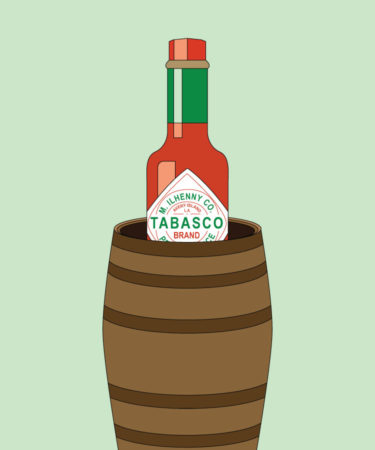Located three miles inland from Vermilion Bay, Louisiana’s Avery Island is a peculiar territory. It’s not so much an island as a 38-acre salt dome surrounded by wetlands, and while it stands at just 160 feet above sea level, it’s one of the tallest points on the entire Gulf Coast.
Situated atop that “island” is an expansive barrel-aging warehouse, packed with thousands of blackened oak casks, which are stacked six high and stretch nearly as far as the eye can see. The contents of those oak barrels is also peculiar: Instead of rye whiskey or bourbon, the ex-spirit barrels hold a mix of mashed peppers and salt that will one day become a fiery red condiment, Tabasco.
In an August 2019 blog post on Tabasco’s website, Coy Boutte, who oversees the aging process and the company’s barrel warehouse, explains how integral the oak barrels are to the production of the iconic red sauce.
“When Tabasco sauce was first produced, stoneware jars were primarily used to age the pepper mash,” he writes. “By 1900, [Tabasco parent] McIlhenny Company had switched to solely using white oak barrels. The reason for this switch is unknown, but the barrel-aging process has been an essential step in the production process for nearly 120 years.”
The remaining ingredients come with their own oddities.
Tabasco sources its peppers from multiple countries around the globe, mainly in Central and South America. Interestingly, the seeds for the pepper plants all come from Avery Island, as does the salt that’s later added. (It is essentially a giant salt mound, after all.)
After the peppers are hand-picked by local farm workers, mashed, and mixed with Avery Island’s finest sodium chloride, the “pepper mash” is transported to Tabasco’s Louisiana facility, where it’s loaded into the white oak barrels.
Tabasco sources the former bourbon barrels from “different distilleries around the country,” Boutte explains. Prior to filling them with the pepper mash, Tabasco employees remove the char from the inner staves, wash the barrels, and rehoop with new stainless-steel rings. This process helps remove any traces of alcohol that may remain within the wood, Boutte explains.
Once filled, the barrel tops are sealed with a protective layer of — you guessed it — salt. The pepper mash will remain in the barrels for up to three years, during which time it slowly ferments. The salt layer atop the barrels allows for the safe release of gasses produced during fermentation, and ensures nothing enters in its place.
After the mash ages, Tabasco workers blend it with “high-quality distilled vinegar” inside large stainless steel tanks. The mixture marries for 28 days, before it’s strained, bottled, and ready to season some delicious Gulf Coast oysters — or any number of dishes enjoyed in the 195 nations worldwide in which Tabasco is sold.
If the barrels are still in good condition once the pepper mash is removed, they’ll be used many more times. Boutte claims “a barrel is typically used 15 to 20 times on average, which is about 35 to 40 years.” He also claims some may be close to 80 or even 90 years old.
At any given time, Tabasco’s warehouse holds between 68,000 and 73,000 barrels. Once deemed unfit for more aging, their journey still isn’t over.
“When we determine that a barrel can’t be reused, we break down the barrel and send the wood out to make Tabasco Wood Chips,” Boutte notes. “The barrel’s stainless-steel hoops are reused for other barrels.”
Other used Tabasco barrels come full circle, and are once again used to age spirits. In 2018, Tennessee “whisky” producer George Dickel announced a new, Tabasco-cask-finished expression, which also includes a distilled Tabasco sauce “essence” that’s blended with the whiskey.
For further fiery libations, one might enjoy a Tabasco-spiked bourbon cocktail — with a salt rim, of course.
